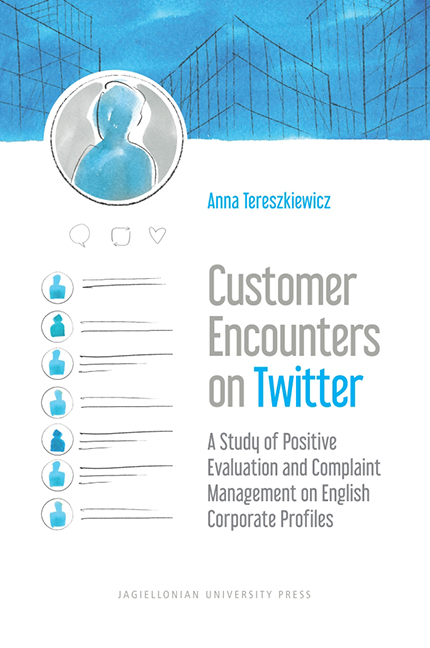 Customer Encounters on Twitter
Customer Encounters on Twitter Book contents
- Frontmatter
- Table of Contents
- Acknowledgements
- Introduction
- Chapter 1 Social media and corporate communication
- Chapter 2 Customer encounters as a genre of social interaction
- Chapter 3 Corporate profiles on Twitter – general characteristics
- Chapter 4 Positive evaluation and complaint management on Twitter
- Chapter 5 Selected politeness and lexicogrammatical properties of the tweets
- Conclusions
- References
Chapter 2 - Customer encounters as a genre of social interaction
Published online by Cambridge University Press: 09 February 2022
- Frontmatter
- Table of Contents
- Acknowledgements
- Introduction
- Chapter 1 Social media and corporate communication
- Chapter 2 Customer encounters as a genre of social interaction
- Chapter 3 Corporate profiles on Twitter – general characteristics
- Chapter 4 Positive evaluation and complaint management on Twitter
- Chapter 5 Selected politeness and lexicogrammatical properties of the tweets
- Conclusions
- References
Summary
Customer encounters as a genre of social interaction – basic characteristics
Customer encounters, i.e. encounters between customers/users and company representatives, represent an instance of institutional discourse, defined as “verbal exchanges between two or more people where at least one speaker is a representative of a work-related institution and where the interaction and the speakers’ goals are partially determined by the institution at play” (Freed 2015: 809, cf. Drew and Heritage 1992).
One of the earliest definitions of customer encounters was provided by Merritt (1976), who defines a service encounter as “an instance of face-to-face interaction between a server who is ‘officially posted’ in some service area and a customer who is present in that service area, that interaction being oriented to the satisfaction of the customer's presumed desire for some service and the server's obligation to provide that service” (Merritt 1976: 321).
The above-mentioned definition concerned face-to-face encounters carried out in a store, but service encounters may also take place in institutional and professional contexts (Gutek 1999: 605), and may be carried out in a mediated form through a phone call or, increasingly, through online channels of communication.
A broader definition encompassing the different contexts and purposes of a service encounter was suggested by Ventola (2005), who refers to encounters as “everyday interactions between the customer and the server whereby some commodity (information or goods) will be exchanged” (Ventola 2005: 19).
Customer encounters represent a ritualized communicative situation (Bayyurt and Bayraktaroglu 2001, Economidou-Kogetsidis 2005) and are viewed as a standardized genre with characteristic actions and moves, as social activities characterized by socially shared, regular patternings (Ventola 1987, Biber and Conrad 2009). The most important distinctive features of such an interaction in offline communication, i.e. face-to-face, telephone or written communication, comprise its incidental and short-term character. The participants are usually strangers and motivated by transactional or instrumental goals (Coupland 2000). With regard to language and politeness conventions, encounters tend to be characterized by the use of conventional politeness acts and the use of the standard variety of language (Economidou-Kogetsidis 2005: 257). The discourse of service encounters is referred to as “quasi-conversational” (Hutchby and Wooffitt 2008: 151).
- Type
- Chapter
- Information
- Customer Encounters on TwitterA Study of Positive Evaluation and Complaint Management on English Corporate Profiles, pp. 41 - 76Publisher: Jagiellonian University PressPrint publication year: 2022


